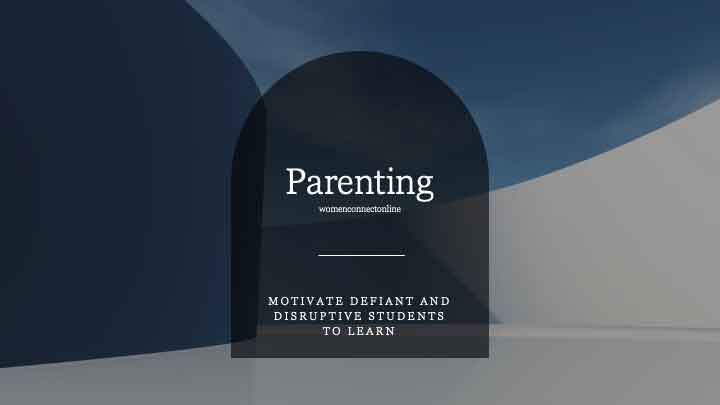Motivate Defiant and Disruptive Students to Learn

By Rich Korb
Children Are Born With Natural Curiosity. What happened?
Helen Keller stated: “One of the first tasks in motivating students to learn is to arouse their curiosity and sustain the interest through time.” Who could possibly know better? If a youngster stops asking why, they will cease to grow in their understanding of life. They become defiant and disruptive.
What Happened to Natural Motivation?
The decay of America’s Youth, and who’s to blame. Today’s youth are looking for adult leadership. Parents, guardians and surrogate parents (We will refer to this group as parents.) need to set the bar, and model those expectations before youngsters will believe and follow. No double standards. Young people are looking for someone to follow. Young people want a leader. They want adults who are brave and strong leaders, even when youngsters say, “No!” Parents need to be firm and fair with the purpose of guiding children toward the adults they want them to be.

With all the discussion regarding apathy in today’s young people, readers might wonder what has become of intrinsic motivation. Youngsters were born self-starters, so what changed? How we respond to experiences will drive us toward our full potential, or divert our efforts away from what we can become. Defiant and disruptive behaviors are often driven by experiences in the home. Hence, young people are no longer self-starters but are parroting the learning they have acquired outside themselves. Their choice to align with those outside behaviors needs to be redirected toward an understanding of personal choice. Defiant and disruptive students have chosen or been guided down the path they are on. It is the parents challenge to refocus youngsters toward becoming self-starters.
This is particularly hard at the elementary level due to the student’s lack of life experiences. Parents of primary age children need to make greater efforts into their child’s motivation due to the child’s psychological bonds with adults. Pre-adolescent and adolescent youngsters have more life experiences to reflect upon and need to be challenged regarding their future goals and dreams.
What Works in Motivating Youngsters of All Ages
The three F’s in a youngster’s life are – Friends, Fun, and Food
The three allies in the parent’s life are – Firm (authoritative) and Fair (benevolent) with Purpose (direction)
It is the coupling of these needs which brings about motivation for youngsters and gratification for the parent. Take a look at how the union of these components works toward a peace between youngsters and adults.
Friends, Food and Firm
Youngsters will do anything to be with their friends. By the parent being firm and threatening to separate friends is also a powerful motivator. It is amazing how cooperative youngsters can become when they realize their relationship is about to be severed through firm consequences if a lack of focus on expected behavior can jeopardize the friendship.
Food is always a great motivator for youngsters of all ages. Taking away food from youngsters, especially teenagers, is a dangerous proposition. It’s amazing what youngsters will do for food. When working with a group of youngsters (family, group home, or youth organization) by firmly telling youngsters’ that they will be rewarded with food for cooperation can create a situation where peer pressure will work in the parent’s favor. When all the students have something to gain, they will work together, and the disruptive students will likewise be motivated.
Fun and Fair
When cooperation is perceived as fun, production increases, and youngsters enjoy the process. Youngsters become motivated when they buy into the expectation through fair and benevolent creativity on the part of the parent. Fun can be obtained through activity projects, variety in processing methods for completing the expectation, shifts in processing approaches every 15 minutes, role-play, and games. Variety creates increased interest and a sense of anticipation. Perceived fairness in a youngsters mind creates a mutual cooperative environment enjoyed by parent and child.
Purpose
The purpose of parenting is to guide their children toward the adults they want them to be. Each parent must answer the question – What do I want my children to be emotionally, mentally, physically, and spiritually? A large part of the outcome will be determined by parent modeling. A child brought up with double standards will soon begin to accept that there is one set of standards for adults and another for youngsters. No double standards can exist in a home where parental desires for their children are not modeled and reinforced for the children. If the parent wants their child to be caring and responsible the parent must demonstrate those behaviors. The research bears out, that children under the age of 8 are likely to mimic what they observe in their parents. Adults are much more capable of making calculated decisions due to their life experiences. Youngsters have limit experiences and even fewer resources, hence they will imitate what they observe in adults, hence adults cannot expect young children to make adults decisions.
Surrogate Parenting
Youngsters go through the natural process of physical, mental, emotional, and spiritual maturation. Accepting that youngsters are moral agents allows us to understand they are naturally going to challenge authority. Understanding that they often inherit this problem allows us to not take the behavior personally. In other words, you didn’t raise the student, so don’t own what you cannot control. When adolescents explode with defiance, what they are really looking for is the caring individual who will let them vent and then offer support in place of criticism. Youngsters should be understood and accepted for who they are, not who they want people to think they are through dress, hair, tattoos, piercings, and disruptive behaviors.
True Encounter –
The student had a vile mouth and did not care what anyone thought of him. When one of his teachers ignored his behavior, it provided him the opportunity to reflect on his comments. The teacher stuck to the task of teaching and calling the student’s bluff from time to time, as a result the student became productive, a leader in the class, and a whistle-blower when other students became defiant. But in other classes, he continued to be defiant and showed little academic progress.
What was the difference? Was it the subject matter? Was it the seat assignment? The answer is yes, to a limited degree, in both of these areas. But more important, in the class where the student began to make a turnaround, he was allowed to push the teacher’s buttons and get no direct response from the teacher. In the class where he was improving, he discovered the classroom and teacher were safe, and he did not need to put up defenses, because nobody was going to take up his challenge.
The turning point came when the student looked straight into the eyes of the teacher with the most defiant look he could muster and said, “F—you,” in a soft and intimidating tone. The teacher’s quiet response was, “Tell me something I haven’t heard before.” The student did not respond. He only looked confused, and he never acted out again.
After that, when the student was having a bad day, he would tell the teacher. More important, sometimes he would ask for a different seat, so he would not be tempted to act out. The student knew he was not going to be condemned, made an example of, or sent to the office, and that his parents would not be called. He felt understood and accepted for who he was, not what he wanted people to think he was.
What the Research Says About Motivating Learners
From the literature on what motivates students to learn, the following key concepts were obtained from a wide collection of sources in a variety of formats. Here is a summary of what research has shown to be the top six motivators for learning:
1. Student control of learning. The focus here is learning. Assessment of learning styles and adapting lesson delivery is vital. If students feel they have their grades in their control (whether they actually do or not), the most resistant learners will engage and take ownership.
2. Relevance to student use and teacher’s genuine interest. There is a dual emphasis between relevance and genuine interest. Why a lesson is important and how it connects to life is best embraced by the student when the teacher demonstrates genuine interest in the subject and students.
3. Teacher’s enthusiasm. Teacher enthusiasm is vital. If a teacher has been assigned to a grade level or curriculum that he or she is not necessarily interested in, it’s time to find the silver lining in the cloud. Students are perceptive and read their teachers’ every action, reaction, and comment. Teachers must be excited about what they are bringing to the students if they expect the students to be interested.
4. Quick feedback and assignment return. Student performance is directly correlated to the time between assignment submission and return. Students’ learning increases when they can make adjustments to errors in a timely fashion. Teachers should strive to return student work the next day.
5. Instructional variety. Technology has provided the opportunity to deliver instruction in a variety of ways. Three shifts in approach to curriculum delivery during a 50-to 60-minute period will help student interest remain high and engaged. Shifting from lecture to group work to independent study keeps students connected and interested.
6. Encouragement. A simple pat on the back, a smiley face stamp, writing “Good Job!” or acknowledging effort can make a big difference in student performance.
Shift Directions to Retrieve Drifting Students
Students and teachers often approach the classroom with different expectations. Essentially, they are traveling parallel paths heading toward their educational goals. However, they are not always traveling at the same rate, and sometimes their paths diverge. Therefore, teachers must make efforts to connect with the students. When a student moves away from the educational goals of the curriculum and the teacher’s direction, it becomes paramount for the teacher to shift direction in an attempt to come alongside the drifting student. As the teacher continues to make these adjustments to the student’s behavior, the chances for personal connection and academic motivation improve. One degree in a shift of two parallel paths will ultimately lead to a connection.
Remember This
Mixing intervention strategies keeps defiant students off balance. They know that defiant behavior will be addressed; they just don’t know when and what form it will take.
Conclusion
I’m confident you will find solutions to motivating youngsters within the pages of our book – Motivating Defiant and Disruptive Students to Learn; published by Corwin Publications. Motivational solutions which will help make your house or the schoolhouse a place you, as well as your youngsters, will look forward to being each day.
The book explores the reasons for disruptive and defiant behaviors and what can be done to motivate them into self-starters. We will look at our responses to these behaviors and how we might be contributing to some of the problems. We will consider what motivates youngsters and how to connect with them, as well as how to manage their behavior, both on an individual basis and from the standpoint of managing a group.
There is hope for a brighter tomorrow, because you are the leader young people look to for guidance and motivation. Enjoy the journey.
Behavior Answer Man
Send your questions, concerns, and situations to www.pioneereducationconsulting.com for immediate assistance.
Rich Korb has thirty-four years of parenting and educational experience as a teacher at every level, and as an administrator. Rich and his wife raised three children who are now successful adults with families of their own. Rich has been the  surrogate parent of more than 4,000 youngsters as a teacher, coach, and youth leader. Rich is the author of – Motivating Defiant and Disruptive Students to Learn, published by SAGE/Corwin Publications. Rich Korb is a national speaker, writer and an expert on defiant and disruptive behavior. Rich presents seminars and webinars through his company Pioneer Education Consulting, and is an adjunct faculty member for Seattle Pacific University and Brandman University where he teaches the course – Motivating Defiant and Disruptive Students – Strategies That Work. Rich Korb has designed innovative strategies to enhance student learning while reducing disruptions due to disruptive and defiant behavior. Currently, Rich is a high school history teacher, author and speaker.
surrogate parent of more than 4,000 youngsters as a teacher, coach, and youth leader. Rich is the author of – Motivating Defiant and Disruptive Students to Learn, published by SAGE/Corwin Publications. Rich Korb is a national speaker, writer and an expert on defiant and disruptive behavior. Rich presents seminars and webinars through his company Pioneer Education Consulting, and is an adjunct faculty member for Seattle Pacific University and Brandman University where he teaches the course – Motivating Defiant and Disruptive Students – Strategies That Work. Rich Korb has designed innovative strategies to enhance student learning while reducing disruptions due to disruptive and defiant behavior. Currently, Rich is a high school history teacher, author and speaker.







